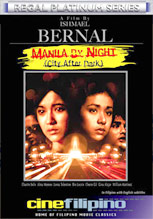
… bekommt man digital gefilmt cineastisch nicht hin. Behauptet jedenfalls „Tilman Baumgärtel“:http://www.tilmanbaumgaertel.net/ im „Philippine Inquirer.“:http://services.inq7.net/print/print.php?article_id=22696 Mit was sich ein deutscher Lehrer an einem Filminstitut in Manila so alles beschäftigt. Hier ein Ausschnitt aus „The downside of digital“
I don’t know any other national cinema where night scenes are given such importance as in Philippine cinema. Apart from the American film noir, Philippine movies must be among the darkest in the world. Consider the frequent reference to the pa-siyam (novena) lit by candles, or the attack of the aswang under a full moon, a gripping chase scene in the dark back alleys of Manila, or the lovemaking in a pigsty in “Himala.” In Philippine cinema the night is often among the principal characters. It can be haunting, as in Mike De Leon´s “Itim,” or full of pitch-black despair as in Lino Brocka´s “Maynila, Sa Kuko ng Liwanag.” It might ooze with sensuality as in Ishmael Bernal´s “Manila by Night” or serve as the appropriately gloomy backdrop as in Chat Gallardo´s “Geron Busabos.”
In no other area does digital cinema look as poor as in such night scenes, and there seems to be little improvement in this area, thus depriving Philippine cinema of one of its most important characteristics.
Aber er bringt hier auch Argumente gegen das digitale Filmen (für’s Kino, natürlich nur) schlechthin, die auch für den europäischen Cineasten bedenkenswert sind …
Ich denke, wir warten einfach auf einen „LowKey“:http://de.wikipedia.org/wiki/Lowkey Filter für Digicams, der das Problem löst, oder etwa nicht ?
Zum Bild oben:
„Manily by night“ ist einer der Super-Klassiker des sozialkritischen philippinischen Films der 70er Jahre. Auf Geheiss von Imelda Marcos musste er in „City by night“ umbenannt werden, weil sie nicht glauben wollte, dass es in Manila (wo sie zu der Zeit Bürgermeisterin war) solchen Niedergang geben könne… (Tilman Baumgärtel)
